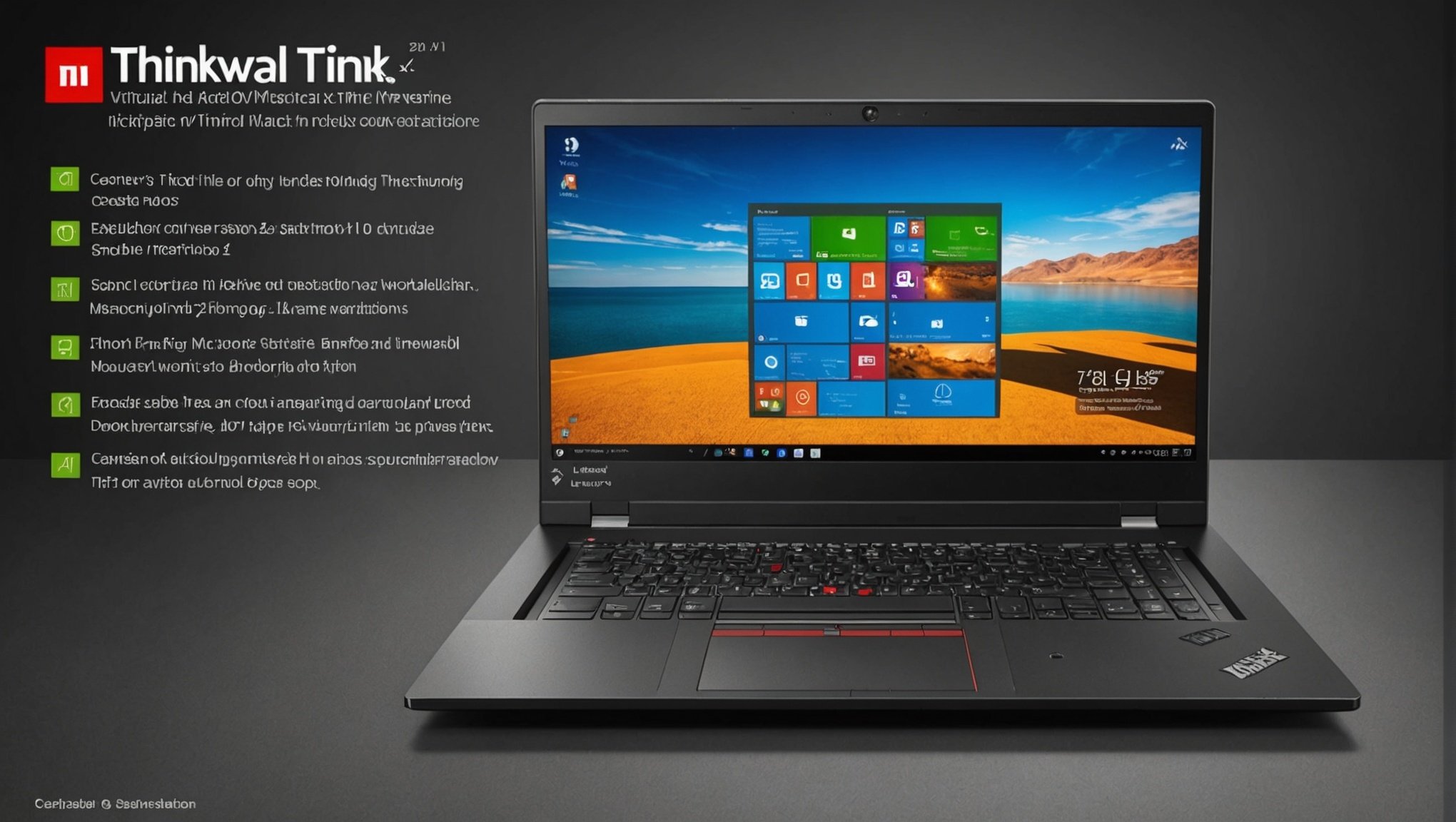Unlock the full potential of your Lenovo ThinkPad X1 Extreme by mastering virtual machines. This guide walks you through configuring VMware Workstation, making virtualization accessible and manageable. Whether you’re a seasoned developer or a curious novice, our step-by-step approach ensures you harness the power of virtual environments to streamline your workflows. From installation to optimization, enhance your productivity and explore endless possibilities with your device. Let’s get started!
System Requirements for VMware Workstation
Before installing VMware Workstation, it's crucial to ensure your device meets the necessary system requirements. Both minimum and recommended specifications are outlined to guide users for optimal performance.
In parallel : Ultimate Guide: Setting Up a High-Performance 3D Rendering Workstation with AMD Threadripper 3960X
Minimum and Recommended Hardware Specifications
For a smooth experience, the Lenovo ThinkPad X1 Extreme is a commendable choice, given its robust hardware. At a minimum, VMware Workstation requires an x86-based processor with 64-bit support, 1.3 GHz or faster. However, for better performance, a multi-core processor with a speed of 2 GHz or higher is recommended. Memory-wise, a minimum of 2 GB RAM is necessary, though 4 GB or more is advised for running multiple virtual machines concurrently. Ensure your device has at least 1 GB of free disk space for the application, plus additional space for each virtual machine.
Operating System Compatibility
VMware Workstation is compatible with a variety of operating systems. It supports Windows 10, 8, and 7, as well as several Linux distributions. Always check for the latest compatibility updates to ensure seamless integration.
Have you seen this : Top Strategies for Configuring a Safe File Server with Intel NUC and Windows Server 2022
Software Prerequisites for Installation
Before installation, ensure that your system has the latest updates and service packs. Additionally, administrative privileges are required to install and configure VMware Workstation.
Downloading and Installing VMware Workstation
To begin using VMware Workstation, follow these step-by-step instructions for a seamless download and installation on your Lenovo ThinkPad.
Downloading VMware Workstation
- Visit the VMware website: Navigate to the official VMware website to find the latest version of VMware Workstation.
- Select the version: Choose the appropriate version compatible with your operating system.
- Download the installer: Click the download button to save the installer file to your device.
Installing VMware Workstation
- Locate the installer: Find the downloaded installer file on your Lenovo ThinkPad.
- Run the installer: Double-click the file to start the installation process.
- Follow the prompts: Proceed through the installation wizard, accepting terms and conditions.
- Choose installation options: Select typical or custom installation based on your preference.
- Finish installation: Complete the process by clicking "Finish."
Licensing Options and Activation
Upon installation, you will need to activate VMware Workstation. You can choose between a trial version or purchase a license key for full access. Enter the license key in the activation window to unlock all features, ensuring your Lenovo ThinkPad is ready for virtual machine management.
Initial Configuration of VMware Workstation
Once VMware Workstation is installed on your Lenovo ThinkPad, it's time to dive into the VMware Configuration for optimal performance.
Customizing Settings for Optimal Performance
Begin by accessing the Settings menu. Here, you can adjust preferences to enhance efficiency. It's crucial to allocate sufficient resources, such as CPU and memory, to each virtual machine. This ensures smooth operation and prevents system lag.
Creating Your First Virtual Machine
Creating a virtual machine is a straightforward process. Navigate to the Virtual Machine Setup wizard and follow the prompts. You'll need to select the operating system and specify the virtual hardware settings. Make sure to allocate enough disk space based on your usage needs.
Managing Resources Allocated to Virtual Machines
Balancing resource allocation is key to maintaining performance. You can manage CPU cores, memory, and disk space through the Settings menu. Adjust these resources based on the demands of your virtual machines. For instance, a virtual machine running intensive applications may require more RAM and CPU power. Regularly review and tweak these settings to ensure your Lenovo ThinkPad remains responsive while operating multiple virtual machines.
Networking Options for Virtual Machines
When setting up virtual machines, understanding VM Networking is crucial for establishing connections. Different networking modes cater to various needs, each with unique configurations and benefits.
Understanding Different Networking Modes
Virtual machines can connect to networks using several modes. Bridged Mode allows a VM to appear as a separate physical device on the network, providing direct access to the host's network. This mode is ideal for applications requiring full network access. NAT Configuration (Network Address Translation) is another popular option, where the VM shares the host's IP address. This is useful for scenarios where network security is a concern, as it hides the VM's identity.
Configuring Bridged and NAT Settings
To configure these settings, access the Network Adapter settings in VMware Workstation. Select Bridged Mode for direct network access or NAT for shared access. Adjust the settings according to your network requirements, ensuring the VM is properly configured for your desired use case.
Troubleshooting Network Issues in VMs
Network issues can arise in virtual environments. Common problems include connectivity loss or incorrect IP assignments. Verify network settings and ensure the correct mode is selected. Regularly updating VMware tools can also help resolve these issues, enhancing network stability.
Utilizing Snapshots and Clones
In the realm of virtual machines, VMware Snapshots and VM Cloning are indispensable tools for efficient management and backup solutions.
Creating and Managing Snapshots
VMware Snapshots allow you to capture the state of a virtual machine at a specific point in time. To create a snapshot, navigate to the VM menu and select "Snapshot." This process is straightforward and provides a safety net for testing and updates. Managing snapshots involves periodically reviewing and deleting outdated ones to conserve storage space.
Benefits of Using Snapshots for Testing
Snapshots are particularly beneficial for testing environments. They enable users to revert to a previous state if an update or software installation causes issues. This capability minimizes downtime and enhances the reliability of testing processes, making it easier to experiment without permanent consequences.
Cloning Virtual Machines for Efficiency
VM Cloning is the process of creating an exact replica of an existing virtual machine. This is invaluable for deploying multiple instances with identical configurations swiftly. Cloning saves time and ensures consistency across virtual environments, which is crucial for large-scale deployments or when setting up development and testing environments. Cloning also aids in backup solutions by providing an additional layer of redundancy.
Performance Optimization Techniques
Enhancing the performance of VMware Workstation on your Lenovo ThinkPad X1 Extreme involves strategic VM Resource Management. By optimizing settings and resource allocation, you can ensure smooth operation.
Adjusting Virtual Machine Settings
Begin by adjusting the virtual machine settings to suit your workload requirements. Increase CPU and memory allocation for VMs running intensive applications. Ensure that the total resources assigned do not exceed the host's capacity, as this can lead to system instability.
Tips on Resource Allocation and Management
Effective resource management is key to optimal VMware performance. Allocate resources based on the specific needs of each virtual machine. For instance, a VM dedicated to light tasks may require fewer resources compared to one running complex simulations. Regularly review and adjust these allocations to match evolving demands.
Using Performance Monitoring Tools
Leverage performance monitoring tools to track and analyze VM activity. These tools provide insights into resource utilization, helping identify bottlenecks or inefficiencies. By monitoring metrics such as CPU usage, memory consumption, and disk I/O, you can make informed decisions to optimize VMware performance on your Lenovo ThinkPad X1 Extreme.
Troubleshooting Common Issues
Navigating VMware Workstation can sometimes lead to unexpected challenges. Understanding VMware Troubleshooting is essential for resolving these issues efficiently.
Identifying Frequent Problems
Users often encounter common errors such as installation failures, virtual machine startup issues, and network configuration problems. These can stem from incompatible software, insufficient resources, or misconfigured settings.
Step-by-Step Solutions for Common Errors
-
Installation Failures: Ensure your system meets all hardware and software prerequisites. Verify the installer file is complete and not corrupted.
-
Virtual Machine Startup Issues: Check resource allocation. VMs may fail to start if they exceed available CPU or memory. Adjust these settings in the Resource Management menu.
-
Network Configuration Problems: Revisit network adapter settings. Ensure the correct mode (Bridged or NAT) is selected and properly configured.
Resources for Additional Troubleshooting Support
For further assistance, consult VMware's official support documentation. Online forums and communities can also offer valuable insights and solutions from experienced users. Engaging with these resources can provide additional troubleshooting strategies and enhance your understanding of VMware Workstation.
Advanced Features of VMware Workstation
In the realm of Advanced VMware Features, leveraging VMware Tools can significantly enhance virtual machine functionality. VMware Tools are a suite of utilities that improve the performance and management of virtual machines. They enable seamless integration with the host system, offering features such as improved graphics performance, better mouse synchronization, and enhanced network capabilities.
Leveraging VMware Tools for Better VM Functionality
Installing VMware Tools is crucial for optimizing virtual machine performance. They provide drivers and utilities that improve the interaction between the host and guest operating systems. This includes features like time synchronization, clipboard sharing, and drag-and-drop functionality, which streamline user experience and boost productivity.
Exploring Advanced Settings for Experienced Users
For seasoned users, delving into advanced settings can unlock a plethora of customization options. These settings allow for fine-tuning of virtual machine operations, such as configuring specific hardware compatibility modes or adjusting resource allocations beyond standard parameters. This level of control is ideal for users seeking to tailor their virtual environments to precise specifications.
Integrating VMware with Other Software Solutions
Integration of VMware Workstation with other software solutions enhances its utility in diverse environments. By connecting with cloud services or third-party management tools, users can extend the capabilities of VMware, enabling more comprehensive virtual infrastructure management. This integration facilitates smoother workflows and improved system interoperability.
FAQs on VMware Workstation and Lenovo ThinkPad X1 Extreme
Navigating VMware Workstation on a Lenovo ThinkPad X1 Extreme often raises common user questions. Here, we address some frequently asked questions to enhance your understanding and experience.
What are the common setup issues on Lenovo ThinkPad?
Precision in setup is crucial. Users often encounter installation errors due to incompatible software or insufficient resources. Ensure your Lenovo ThinkPad meets the system requirements and verify that all software prerequisites are fulfilled.
How can I resolve device-specific issues?
Device-specific issues, such as performance lags or connectivity problems, can often be resolved by updating drivers and adjusting resource allocations. Ensure your Lenovo ThinkPad has the latest firmware and drivers installed for optimal performance with VMware Workstation.
Where can I find additional information on VMware Workstation?
For further guidance, consult VMware's official documentation and support forums. These resources provide comprehensive information and community-driven solutions, enabling users to resolve issues and optimize their virtual environments effectively. Engaging with these platforms can significantly enhance your troubleshooting skills.
Resources for Further Learning
For those seeking to deepen their understanding of VMware Workstation, a wealth of VMware Resources is available to explore. These resources range from official documentation to community-driven support, providing comprehensive guidance for both novice and experienced users.
Recommended Documentation and User Guides
The official VMware documentation is a crucial starting point. It offers detailed user guides and technical manuals that cover various aspects of VMware Workstation, from basic setup to advanced features. These guides are meticulously curated to ensure clarity and precision, making them indispensable for troubleshooting and configuration.
Online Forums and Communities for VMware Users
Engaging with online forums and communities can significantly enhance your learning experience. Platforms such as the VMware Community Forum and Reddit's r/vmware provide a space for users to share insights, solutions, and best practices. These communities are invaluable for real-world advice and troubleshooting tips, fostering a collaborative learning environment.
Additional Courses and Tutorials for Advanced Learning
For those looking to advance their skills, numerous tutorials and courses are available online. Websites like Udemy and Coursera offer structured courses that delve into complex VMware Workstation functionalities. These courses often include hands-on labs and exercises, enabling users to gain practical experience and deepen their expertise.











